Not including my not-so spectacular rubber duck antennas, I have two antenna types I use for 2 meter operation: j-pole made from copper pipe, and slim jim made from 450 ohm ladder line. I have two j-pole (both from KB9VBR) antennas, and 3 slim jim antennas (1 bought from N9TAX, and 2 I built myself). This post will deal with the j-pole antennas. For the slim jim antennas, see part 2 (coming soon).
After becoming licensed in the first half of 2013, I wanted to get a big mamba jomba antenna that performed better than my rubber duck antennas. I initially wanted to place an antenna outside on my roof, but my wife was still not won over to my new hobby and wasn’t all that keen on me marring up her cherished roof. And to be fair, she did point out that I didn’t entirely know what I was doing.
“And you’re like Tim Taylor from Home Improvement!” she had said. “The minute you get up on the roof, you’ll get tangled up in something, fall down, and break your neck. And then I’d have to go through the effort of finding a new husband who isn’t so stupid.”
I also realized, my HOA would probably cry foul if I put an antenna on my roof. Big bunch of babies.
With a little bit of research, I decided to mount an antenna in my attic. I ventured up there early in the morning while it was still cool. I figured it would be somewhat of a good idea to figure out how much room I had to work with before I bought an antenna.
I was surprised to find out how little room there was between each set of king posts and trusses. An antenna with radials was out of the running. Some more research, and I determined a j-pole would be best for my antenna needs.
I went with a copper pipe j-pole from KB9VBR. It got decent reviews and didn’t cost an exorbitant amount of money. Before I ordered it, I measured the open vertical space in the attic — barely enough room.
Mounting the J-Pole In The Attic
I was excited for my new antenna, but then I thought, “How to mount the blasted thing?”
I came up with some ideas, some overly complex, and others massively overly complex which would have involved the use of an advanced gyroscope and liberal use of duct tape. My wife reminded me of my New Year’s goal: KISS (keep it simple, stupid).
I went through my scrap lumber and junk. I found an old mount for a TV antenna I could use, and I had plenty of spare 2×6 pieces of lumber. I figured I’d screw in a length of a 2×6 between two king posts, and then screw the antenna mount to the 2×6. Problem was, the 2×6 wasn’t the right size to screw the antenna mount to it. Yep. I could have easily gone to Lowe’s and pick up a 2×10, or a 1×10, and the mount would have fit perfectly, but why keep things that simple?
I cut some pieces of wood, assembled them, and then screwed on the mount. I took the W7KBX designed advanced mounting kit up to the attic and screwed it between two king posts. I then stood on it, jumped up and down as hard as I could, and kicked it several times just to make sure it was sturdy enough to hold a 5 pound antenna. Ok, no, not really. I wrote that to give my wife a startle.
I then attached the copper pipe j-pole to the mount with u-bolts. I drilled a hole and ran the feed line down into my ham shack, and then connected it to the antenna. Even though I live in a dry area, I wrapped the connection with electric tape, just to prevent any potential moisture intrusion.
It was challenging and a bit dangerous to do all that up in the attic. In retrospect, I’m amazed I didn’t come crashing through the bathroom ceiling. I spent about 30 minutes up there. It was exhausting! And it got quite warm. I was wearing overalls, and was weighed down with wood clamps, a cordless drill, a level, a socket wrench (or so I thought), extra screws, a flash light, a water bottle, and drill bits. Balancing on the beams and joists while driving screws was a fatiguing experience I hope to never do again.
I hobbled my way back to the attic access which was in the garage, climbed down the ladder, emptied all my pockets, dumped my tools on the work table, and immediately began stripping off my clothes which were covered in dust and insulation. I then heard my next door neighbor (female) shout, “Hey Kyle, as much as I enjoy a good peep show, you may want to shut your garage door before you take off your skivvies.” Oy! The things we forget when we are tired.
After shutting the garage door, I threw my itchy clothes to a corner, vowing to burn them instead of trying to clean them.
After showering and dressing, I prepped the coax leading from my attic, attached my 5W HT, and let out a test transmission. I got the courtesy beep from the repeater, followed by a signal report from KE7YEM. The J-Pole was performing perfectly.
My Mistake / The Entity
I went back out to the garage, folded the ladder, and put it away. I then began putting my tools away. I thought, “Wouldn’t it be horrible if I had left a tool up in the attic?” I did a quick inventory of my tools. Everything was accounted for except for my socket wrench. I checked my attic clothes. No wrench.
Sigh.
After setting up the ladder again, I grabbed the flashlight, climbed back up the ladder, and opened the attic access. I took a few more steps up the ladder and was prepping to move myself over onto the joist, when, with my limited vision, I noticed something peculiar on a nearby truss. I checked my footing on the ladder, and then leaned forward a bit, shining the flashlight on the object. I thought it was an insect nest or something similar. I grabbed a small handful of insulation fluff, and foolishly threw it at the unidentified thing. The blasted thing spread its wings and took flight — right towards me! Bat!
I screamed like a 10 year old girl, lost my footing on the ladder, and grabbed the closest truss. In the process of losing footing on the ladder, I frantically started kicking my feet, causing the ladder to tip over, but it was caught on my shoe. The grumpy bat continued to fly around my head.
Hanging in the attic access opening, I scrambled to gain better support with my arms, one around a truss, and the other gaining support on a joist. The weight of the unstable ladder was pulling me down via my foot. I squeezed my arm around the truss as hard as I could, hoisted the ladder up with my foot and leg, and continued screaming soprano while the flying rat kept flapping its wings next to my ear.
After a few seconds of repositioning the ladder with my feet and legs, it was no longer pulling me downward, so I took a chance and put nearly all my weight on a ladder step. I noticed the ladder didn’t wobble, so I quickly took a few steps down, closed the attic access, and rapidly scurried down the ladder and collapsed on the floor.
As I was gulping deep breaths, I heard my wife laughing uncontrollably. Through her laughs, she wheezed, “That was the funniest thing I’ve ever seen!”
I was going to ask why she hadn’t help me with the ladder, but all I said was, Well, I guess that socket wrench is up in the attic to stay.”
Review of KB9VBR J-Pole
I like it. It is constructed well. The joints are well soldered, nice and shiny. As far as performance, I can easily hit repeaters using only a half watt of power. I bet I could do it with even less wattage, if my radio could be lowered any further.
KB9VBR makes two kinds of j-poles for 2 meter use. One is the standard j-pole, and the other is a break away model which comes in two pieces. The break away model is designed for easier transport, like for a to-go box. The break away j-pole is easy to assemble, you simply screw the top half onto the bottom half. Voila!
My one piece j-pole, which is mounted in my attic, performs great! It can hit all the repeaters in my area with no issues. It performs very well on simplex nets, with just 5 watts of power.
The break away model is a different story though. During the shipping process, the threads of the screw portion of the bottom half were slightly bent, making it impossible for the top half to be screwed in completely, making the antenna nearly half an inch too long. Therefore, the antenna ain’t tuned right. I have no SWR meter, but I’m pretty sure it’s too high for comfort. When I’m using 5 watts of power when using the break away antenna, I start having issues with my transmission being cut off.
I’m sure I could fix the tuning issue on the break away, but it’s just a spare antenna right now anyways, so it ain’t a priority.
All in all, I highly recommend the one-piece j-pole from KB9VBR, and you may have better luck with the break way model than I.

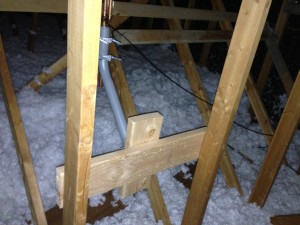
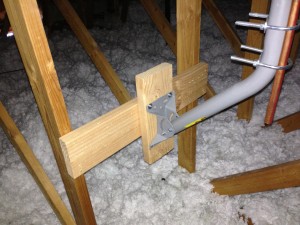
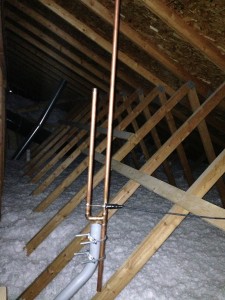
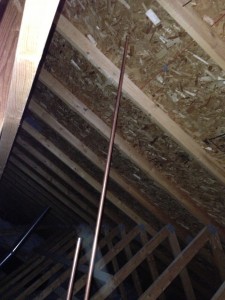
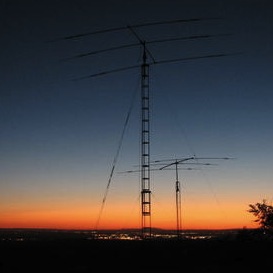
I’m a newly licensed ham. I came across your post about the 2m jpole in your attic. How did you end up grounding the antenna?
Welcome to the hobby.
I didn’t ground it, and it is still not grounded. I have not had any issues.
On the internet, there was, and still is, so much conflicting information on how to properly ground an antenna and a ham station. I had decided to install that j-pole antenna, my first antenna, in the attic specifically because I didn’t know the proper way to ground. In the attic, there is little air motion, hence no static build-up.
Since then, I have erected a 2 meter 70 centimeter antenna outside above my roof-line. I had met another ham who knew what he was talking about when it comes to grounding. It takes effort to do it properly. You have to follow NEC. 99.99% of grounding information you will find on the internet is contradictory and dead wrong.
At some point, I will ground the attic antenna, but it’s hard to motivate me to do so since it won’t gain me any advantage.
If you have questions about grounding, I can point you in the right direction. Also, I have been planning on posting a page here on my website showing off my ground system. I have just been so busy I have not gotten around to it yet. Hopefully soon.
Alight thanks for the follow up. I know what you mean about conflicting info on grounding. I’ve run into that as well the last couple months. The main reason I want to install my first antenna in the attic is to avoid lightening protection work. At some point, I’ll venture to the outside with my antenna.
Also, what kind of range did you get out of the attic antenna? What kind of wattage did your radio have?
Sounds Like you are headed down the same path I traveled. For the first year, I used an FT-60 handheld, max 5 watts. Very decent range. I was able to hit repeaters all over south west Idaho on just half a watt. For simplex use I would bump it up to 5 watts. 10 to 15 mile range. I now have an FT-1900 50 watt rig connected to the attic antenna. I can simplex all over the valley and into Ontario, Oregon.